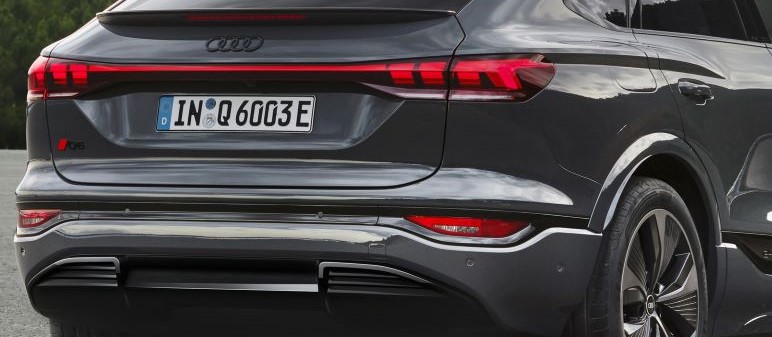
A close-up of the rear lighting system of the Audi Q6 e-tron which integrates six digital rear Atala OLED 2.0 panels, featuring 360 individually addressable, software-controlled segments.
Digital OLED technology allows vehicle lighting systems to go beyond illumination to redefine how cars interact with their environment and other road users.
A new generation of organic light-emitting diode (OLED) technology from OLEDWorks (OLED 2.0) allows for previously unattainable levels of precision and control, enabling automakers to create more dynamic and expressive lighting designs.
Atala OLED panels offer uniform light with individually controlled segments, giving automakers the freedom to customize the lighting design for specific locations and functions on the vehicle.
One of the first vehicles featuring the new technology is the Audi Q6 e-tron, which is fitted with six digital rear OLED panels containing a total of 360 individually addressable segments. In addition to enhancing the car’s visual appeal, the panels act as a real-time communication tool for drivers.
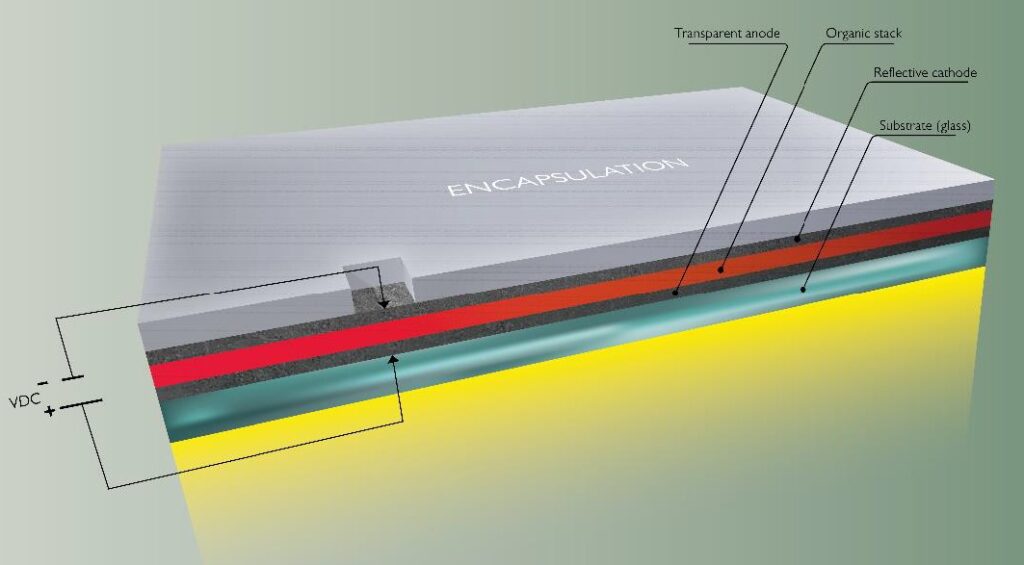
Atala OLED lighting uses dynamic symbols and animations to convey important information like upcoming hazards or changes in road conditions. This creates a safer driving experience and opens new possibilities for communication between vehicles.
The ultra-thin, lightweight profile of OLED panels allows for seamless integration into vehicle designs, whether for exterior lighting or interior ambient lighting. Inside the car, OLEDs create a more luxurious and personalized atmosphere, with smooth, even illumination that enhances the overall driving experience.
Automotive Industries (AI) asked David DeJoy, Co-Founder and CEO, OLEDWorks, to share what inspired his company to develop its second-generation digital OLED technology, and how this new technology is significant for the automotive lighting industry.
DeJoy: The inspiration behind our second-generation OLED technology, which we call OLED 2.0, stems from the continuous need to push the boundaries of what is possible in automotive lighting. In comparison to the first generation, this new technology represents a major leap forward.
One of the most exciting advancements is the expansion from six segments to 60, which allows for much greater control over lighting elements. The segments are not only highly uniform but also have sharp, high-contrast edges with narrow, almost invisible gaps between them.
This enables a much more homogenous light signature per panel. The overall effect is more dynamic and engaging lighting, which allows designers to create bold visual identities for cars.
For example, in the Q6 e-tron, Audi integrated six digital rear OLED 2.0 panels, and these feature a total of 360 individually addressable, software-controlled segments. These segments don’t just contribute to the car’s aesthetic appeal, they also serve as a canvas for real-time communication via Audi’s special algorithm that generates a new image every ten milliseconds.
Audi’s design vision demonstrates a big step toward transforming automotive lighting into something far more interactive and functional.
AI: How does this technology enhance road safety and communication between drivers?
DeJoy: Atala OLED technology brings an entirely new dimension to automotive lighting, particularly when it comes to enhancing road safety and communication. Traditionally, automotive lights have had one primary function—illumination. But with OLED technology, we can go far beyond that.
Atala supports “vehicle-to-everything” (V2X) communication by displaying dynamic symbols and animations that warn other drivers about potential hazards or changes in driving conditions. For example, it can sign

al sudden changes in speed or upcoming road conditions in a way that’s visually engaging and easy to understand.
One of the unique aspects of the Atala panels is that they are adaptive and flexible, meaning they can wrap light around the rear of the vehicle. This enhances the likelihood that other road users, including those on two- or three-wheeled vehicles, will notice a car and its signals.
It’s not just about being seen—it’s about improving the effectiveness of communication. Atala OLED lighting expands the viewing angle, providing a more accurate display of the vehicle’s width, which is crucial for safety.
The digital 2.0 OLED rear lights in the Audi Q6 e-tron expand on this by enabling Audi’s vision for new V2X communication methods. For example, Audi’s proximity indication function is integrated into the OLED 2.0 rear lights. Using data from surrounding vehicles, this communication light is automatically triggered to alert drivers of nearby hazards.
No additional input from the user is needed. It happens in real-time, displaying warning symbols that alert road users to everything from accidents to sudden changes in traffic conditions. This kind of proactive communication is crucial for road safety, particularly as we move toward an era of semi-autonomous and fully autonomous vehicles.
AI: OLEDWorks and Audi clearly have a strong partnership. How did this collaboration shape the development of OLED 2.0 technology?
DeJoy: Audi has been an invaluable collaborator in the development of our OLED 2.0 technology. From the beginning, they have shared our vision of what digital OLEDs could bring to the automotive industry. Audi’s willingness to work closely with us and Tier 1 suppliers helped accelerate the process of bringing this innovative technology to market.
This collaboration between Audi, OLEDWorks, and Tier 1 suppliers has been instrumental in developing not only the OLED light engine but also integrating it into the rear combination lamps of their vehicles. Audi’s expertise as an OEM, combined with our deep understanding of OLED technology, allowed us to collaborate in a way that made a real difference.
This tri-lateral approach to product development helped ensure that the technology met the rigorous demands of both automotive design and functionality.
Audi’s influence is also evident in how they have pushed the boundaries of OLED lighting in previous models, like the Audi A8 and Q8. The Audi Q6 e-tron, though, really marks the next level in terms of functionality and safety. Their team’s design of the lighting not only taps into emotional appeal but also adds significant safety features that truly differentiate Audi from its competitors.
AI: What challenges did you encounter in expanding the OLED technology from six to 60 segments per panel?
DeJoy: We had to tackle several technical challenges along the way. One of the first issues we encountered was electrostatic discharge (ESD) protection. The smaller segments we introduced required a more intricate design to prevent ESD from damaging the OLED panels. We also had to make improvements to our substrate materials to handle this new complexity.
Another significant challenge was ensuring voltage and luminance uniformity across the segments. As we increased the number of segments, maintaining consistent brightness and voltage distribution became critical. To achieve this, we had to refine our modeling processes to predict how the different segments would perform under various conditions.

Furthermore, the connector we used, the Flexible Printed Circuit (FPC) connector, had to be redesigned with a finer pitch to accommodate the increased number of segments. And of course, all of this had to meet the strict automotive qualification and validation tests that the industry requires.
This was especially challenging given the scale we were working on, with so many more segments to test for reliability and performance. Testing for crosstalk between segments was another layer of complexity we had to address, but we were able to overcome these hurdles and ensure the technology was ready for the demands of the automotive market.
AI: How do you see OLED technology continuing to evolve in the automotive industry?
DeJoy: The future of OLED lighting in the automotive sector is incredibly exciting. One of the key advantages of OLED technology is the design freedom it provides. With smooth, even lighting that comes from hidden emitters, we can create large-area segmentation that is completely customizable for each vehicle. This opens countless possibilities for both aesthetic and functional uses.
As we move forward, you’ll see even more advancements in the versatility of OLEDs. For example, we’re developing panels in a variety of colors—amber, white, green, blue, and turquoise—that will provide even greater flexibility for designers.
At the same time, the OLED panels themselves are becoming smaller and more segmented, with increasingly narrow gaps between segments. This will make the light look more like a display, enabling even more complex animations and symbols for V2X communication.
We’re also working on flexible OLED panels, which can conform to the curves of a vehicle. This is a game-changer for design, as it allows automakers to create lighting systems that not only enhance the look of a vehicle but also improve safety by providing better visibility and communication to other road users.
Our multi-stack OLED technology, which allows for higher panel brightness, will continue to set us apart from competitors. With this approach, we can incorporate more active material within the OLED architecture, which results in higher brightness levels.
For instance, we’ve demonstrated red luminance up to 20,000 cd/m² and amber luminance up to 50,000 cd/m², which can be used for a variety of applications, including daytime running lights and V2X communication. This increased brightness also extends the lifetime of the OLED panels, making them more durable and reliable in the long run.
AI: What sets OLEDWorks’ Atala brand apart from other lighting technologies?
DeJoy: Atala OLED lighting offers something truly unique in the automotive industry. Unlike any other lighting technology, Atala provides a combination of beautiful, uniform light with the ability to control each segment individually. This level of segmentation allows us to customize the luminance and the design for each specific location and function on a vehicle.
One of the most compelling aspects of Atala OLED technology is that the light itself, not the lens, is what fulfills the design and functional intentions. This gives carmakers an unparalleled level of design flexibility. Whether the goal is to create a specific look for a luxury sedan or add personalization features to a compact model, Atala can adapt to those needs. It’s a brand built around the idea that lighting should be more than just functional—it should elevate the overall experience of the vehicle.
AI: What impact do you think OLEDWorks’ technology will have on the future of automotive aesthetics and functional lighting?
DeJoy: OLED technology is going to have a profound impact on both the aesthetics and functional aspects of automotive lighting. As we continue to develop more OLED lighting colors, shapes, and higher brightness options, the possibilities for customization will only expand. We’re already seeing OLEDs being used for everything from stop and turn signals to badging and even animated logos.
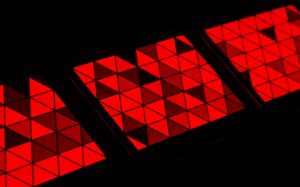
The future will include even more complex applications like V2X communication and autonomous vehicle signaling.
Atala OLED panels have an ultra-thin and lightweight profile, making them easy to integrate into both rear lighting systems and interior spaces. This is a significant advantage over traditional LED systems, which often require bulky lenses and diffusers to achieve high-quality light. OLED panels, on the other hand, deliver smooth, even illumination across their entire surface without needing additional optical elements.
Inside the car, OLED technology creates opportunities for a more luxurious and personalized environment. The light is uniform, fills the space without harsh shadows, and can be integrated into materials like wood, leather, and fabric, adding a level of sophistication that’s hard to match with other technologies.
AI: How does OLEDWorks ensure the reliability and longevity of its OLED products while maintaining high-performance standards?
DeJoy: Atala panels are subjected to thousands of hours of validation testing. They meet all automotive reliability standards and have passed the rigorous tests (e.g., AEC-A-102 standards) of original equipment manufacturers (OEMs) and Tier 1 suppliers. Atala offers the highest brightness, as well as vehicle lifetime longevity—even in extreme temperatures and other harsh road conditions.
Current lifetime standards are set at about 15 years, but Atala products are manufactured to match the expected lifetime of the vehicle. Depending on the vehicle profile and technological requirements, this lifetime can be increased.
AI: What does being a finalist for the 2025 Automotive News PACE Awards mean for OLEDWorks and its future in the automotive industry?
DeJoy: It’s an incredible opportunity to highlight the inherent beauty of digital OLEDs for rear combination lamps, and how they are transforming automotive lighting from basic illumination to a state-of-the-art design experience that enhances functionality, aesthetics, and safety.
This honor also recognizes the incredible teamwork and collaboration that went into the evolution of digital Atala 2.0 OLEDs, including how the technology is inspiring the reimagining of what is possible in lighting design.










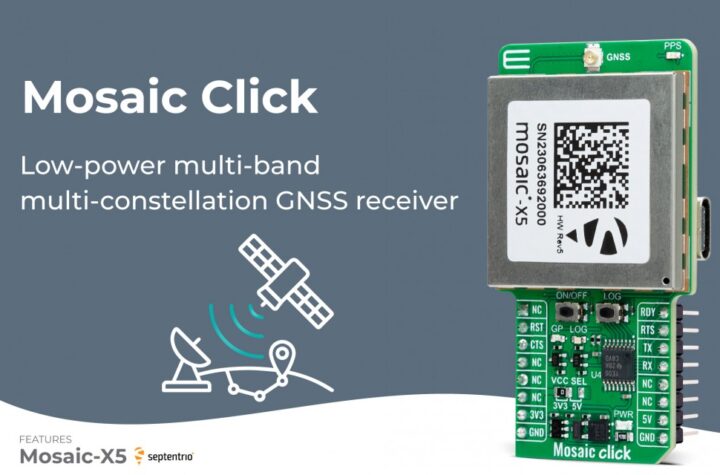
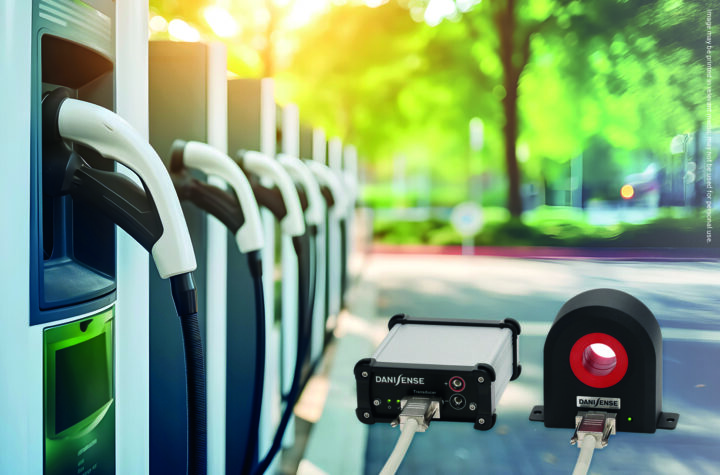
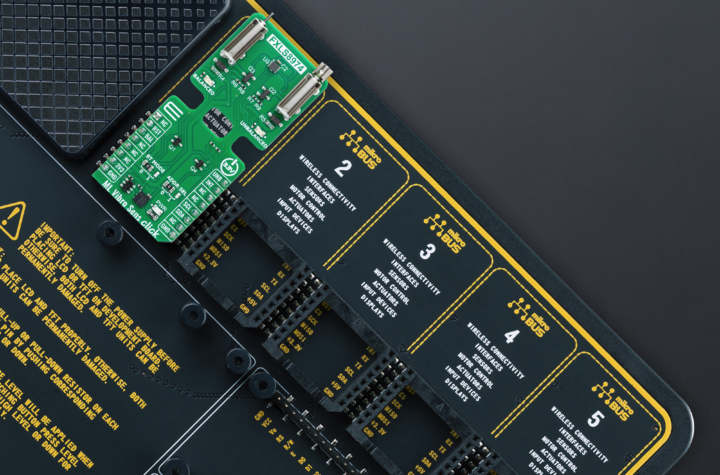

More Stories
Mosaic Click board from MIKROE delivers global coverage multi-band and multi-constellation tracking ability
Current transducer from Danisense selected for DC charging station testing device demonstrator at TU Graz
New Click board from MIKROE helps develop and train ML models for vibration analysis